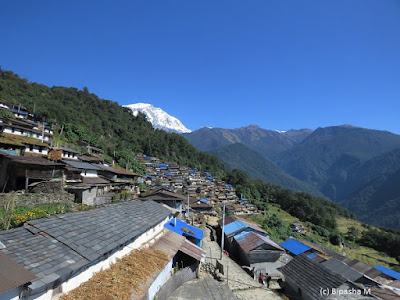 |
| A brilliant day in Sikles, Annapurna Conservation Area. Photo: Bipasha M |
The
scent that lingers in the air, the trail left in the water, the impression made
in space after something or someone has been and gone, the trace of someone’s
perfume. (French)
The bus was packed – all seats occupied,
spaces near the seats filled with luggage, jute sacks, cardboard boxes, gas
cylinders and more luggage. I was about to get down when a woman in the seat
next to the driver’s called out to me and shifted making a bit of a space for
me. I squeezed in. There was a cardboard box kept below, so I put my feet on it
and tried to make myself comfortable. Both the woman next to me and the man
sitting behind the driver started saying something in Nepali. The urgency in
their voice suggested I should not keep my feet on the cardboard box. The next
ten minutes were spent by these two people trying to help me find a place to
keep my feet, which finally was on somebody’s luggage.
The driver (guruji) finally started the bus. A few things moved and resettled
including my leg position. Through hand gestures, actions and broken Hindi, we
communicated. The box contained chickens which were being sent by somebody in
Pokhara to their family in Sikles, a Gurung village high in the mountains. Both
these un-related fellow travellers kept an eye out for the chickens during the
journey up. Everybody was talking to everybody else as if they all knew each
other. I was also pulled into their conversations even though I barely
understood the language. Soon, they all knew that I was a ‘very brave’ woman
travelling on my own from Pokhara to Sikles.
A few kilometers into the mountain and the
bus came to a dead stop. There were two road-rollers ahead working on widening
the narrow mountain roads. Stones and rocks fell as the machines gouged out the
earth from the mountain sides. It meant a delay of one and a half hour or more.
My Nepali saathi had warned me – the first
thing to learn in Nepal is patience. I ate the apple I had bought and then went
off to sleep. After almost one and a half hours, the bus re-started. Everybody settled
back into their respective seats, each looking out for the person next to them.
It was once again like a big happy
family traveling together. Children sat holding onto the arms of strangers
while parents sat elsewhere knowing they will be looked after.
The bus shook and rattled; roads rose,
dipped and fell; my bones felt as if they will come out of their sockets.
People got down, more people got up. Parcels for unknown people were picked up
and dropped. Messages were passed. Beautiful picture perfect villages set against
the backdrop of snow mountains came and went. In five hours, we reached Sikles.
An elderly fellow passenger in the bus
offered me his lovely home to stay. He spoke a bit of English and Hindi and
addressed me as “daughter”. I shifted between calling him “dadju” and “father”.
He took me to the viewpoint early
morning next day from where we could see the himal up close. He treated me to evening snacks of roasted maize
and boiled soy beans all the days I stayed there.
His joyful wife could barely speak Hindi,
so most of our conversations were based on simple words and actions. Other
times, it was intuitive. We joked and laughed a lot also. She told me about her
youngest son who doesn’t live with them anymore. The father and the son had a
fight. She is one of the last few women in the village who still weave sheep
wool into blankets on a traditional handloom.
Their daughter and grand-daughter lived
with them as her husband worked in a foreign land like most young Nepali men. The
daughter was reserved and had striking features. We slowly got speaking and
created a space for ourselves. I helped in the kitchen while she cooked.
This Buddhist Gurung family prayed to Shiva
and their own ancestors. Every time a meal was cooked, it was first offered to
them before given to others. The kitchen leftovers were fed to an old stray cow
with no teeth. The bones were fed to a village dog. Nothing was wasted.
In their own non-intrusive ways, they
looked after me in the short while that I was there. They left me alone to stare
at the mountains and read my book, frequently brining me steaming cups of kalo sugared chiya. It was Tihar, the day I left. The three of us hugged each
other – mother, daughter and I. We held each other long, not a word was spoken,
a silent acknowledgment to the kinship and bond that can exist only between
women.






